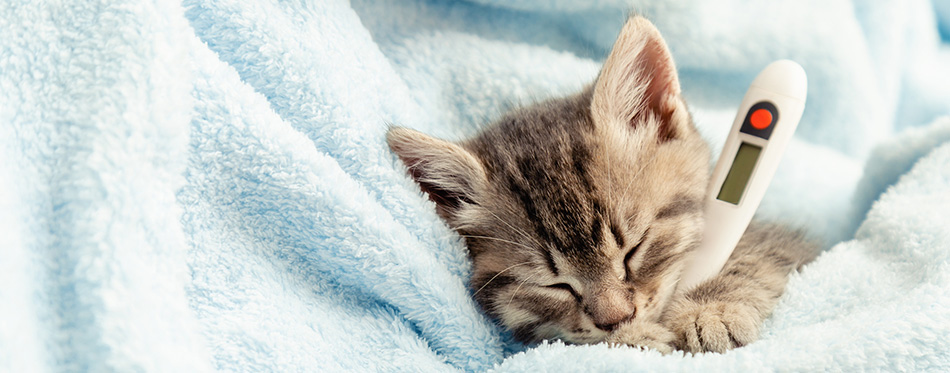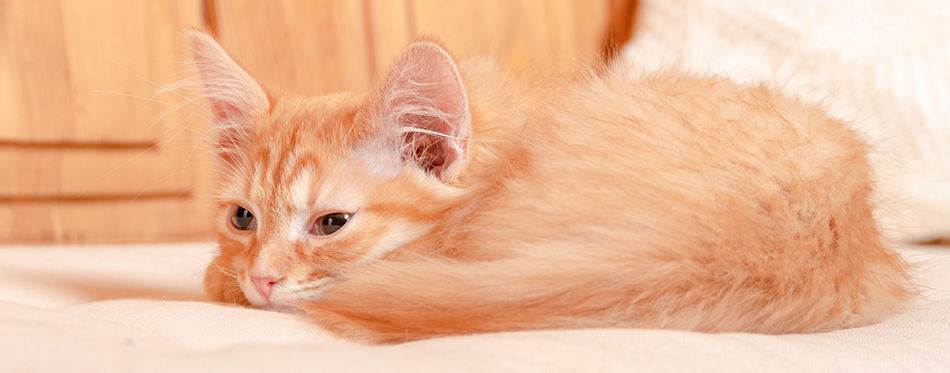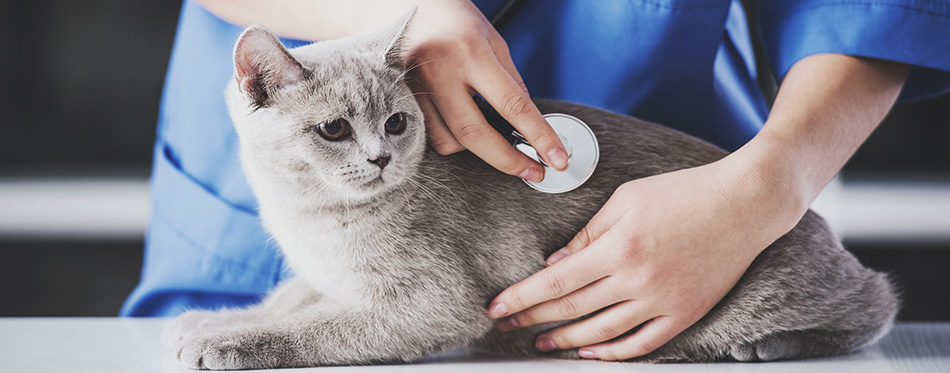While some ailments can be easily and safely treated at home, there are other medical emergencies that require immediate veterinary attention. If your cat or kitten is experiencing any of the emergency situations listed below, it’s essential that you get them immediate medical care. Consulting your vet quickly can save your cat’s life and prevent further damage from occurring. In the case of an emergency, time is of the essence, and the quicker you get your cat to the vet, the better their chance of recovery. The following list examines 10 situations that should never be treated at home. To ensure that you’re prepared for emergency situations, always have your vet’s practice number available and your cat carrier at the ready for swift transportation.

Breathing Difficulties
If your cat is struggling to breathe, you’ve got a medical emergency on your hands. When a cat is struggling to breathe, there are a number of warning signs. They might extend their necks forward, utilize their abdominal muscles to support their breathing, or move their elbows away from their bodies. You might also hear wheezing or noises which signal that they are struggling to breathe. While dogs might pant, or breathe with their mouths open, cats do not do this. So, if your kitty begins breathing in a strange way, you need to consult your vet immediately. Since they might be losing oxygen, it’s essential to keep them as calm as possible in these moments, as panic will lead to greater stress, and this could further hinder their breathing. If you notice that your cat is struggling to breathe, get to the vet immediately, and keep your cat as calm as possible on the way there. It’s also important to call your vet before you arrive so that you can explain the situation before arrival. This means that they can begin their medical interventions immediately and ensure that your cat is once again getting enough oxygen.
Related Post: Cat Calming Sprays
Continual Vomiting and/or Diarrhea
Every cat will have the odd bout of vomiting from time to time, and if it’s a one-off situation, it’s usually not a cause for great concern. They may have eaten something that has upset their tummy, and by purging it, they will usually feel better. However, if your cat is repetitively vomiting or has persistent diarrhea, you will need to make an urgent appointment with your vet. This could be caused by a number of issues (such as ingesting a foreign object, eating something poisonous, or more serious illness) and it can lead to severe dehydration if left untreated. If your cat has been experiencing vomiting and diarrhea continually, you have to get them immediate medical attention. They will probably need to go on a drip to restore their hydration levels, and if something foreign has been consumed, they might need emergency surgery. Sometimes vomiting and diarrhea can point to a more serious illness, and thus your vet might need to run some tests. If your cat’s stools are bloody, it’s also important to see your vet quickly. In these cases, it’s best to act swiftly, rather than to utilize a ‘wait and see’ approach.
Persistent Bleeding
If your cat has an injury and is consistently bleeding, you will need to get them to your vet immediately. Losing large quantities of blood can be dangerous, and wounds if left untreated, can become infected or septic. If your cat has been in a fight or has been injured with an object like metal they might need to go on a course of antibiotics or receive an injection to prevent further infection. Your vet will be able to find the source of the bleeding, clean the wound, and put a stop to the bleeding. If your pet has become impaled with an object, do not try to remove it at home. This could do far more harm than good and could seriously hurt and injure your cat. In these moments, get your cat to your vet immediately. Every second counts when it comes to blood loss, and in extreme cases, your beloved pet might need surgery.
Trauma
Outdoor cats are often vulnerable to various traumas, such as being hit by a car or getting into fights with other cats. If your cat has experienced trauma, it’s essential to get them to the vet immediately. Sometimes the signs will be obvious – blood, limping, cuts, shredded nails, etc. However, other times, your cat might be experiencing internal injuries that are impacting their organs. It’s essential that your vet examines them thoroughly and runs some tests to ensure that there are no serious problems. If you suspect that your beloved cat has gone through some type of trauma, always consult your vet. This will prevent problems from worsening and ensure that your cat doesn’t ensure unbearable pain.

Ingested Poison
If your cat ingests poison, you have a serious medical emergency on your hands. Poison can constitute a number of things, and a number of everyday items in the home can, in fact, be highly toxic to cats. These include:
- Human medications
- Chemicals and pesticides from your home or garden
- Certain plants
- Human foods
Warning signs that your cat has ingested poison might include vomiting, diarrhea, shaking, seizures, breathing difficulties, dilated pupils, confusion, or excessive shivering. You need to get your cat to the vet immediately and if you can collect a sample of their stool or vomit this might help the vet in identifying the problem. If you know what toxin your cat has ingested, bring it with you to show your vet as this might help them in treating the problem. Dealing with these situations effectually can truly save your cat’s life. Time is of the essence when it comes to this type of emergency situation, and acting swiftly can mean the difference between life and death.
Paralysis or Loss of Mobility
If your cat loses the ability to move their hind end, you need to get them to your vet immediately. This could signal a very unpleasant condition known as aortic thrombo-embolism and occurs because of heart disease. In this condition, blood clots can form in their heart, travel through their bloodstream, and block off blood supply to certain areas. Your cat will most likely highlight their discomfort and pain and might pant, showcase agitation, and have paws that are cool to the touch or even blue/grey in color. Get your cat to the vet immediately if they are experiencing the ability to move as it could point to serious heart problems or other medical conditions that need immediate attention.
Seizures
Seizures can be very distressing for pet parents, and they sometimes occur in clusters and can get worse over time. They usually point to a more severe medical condition and could be a sign of epilepsy, brain injury, or the ingestion of poison. It is imperative that you get your vet to the cat as soon as possible if a seizure occurs. Sometimes your cat will also display warning signs that they are about to have a seizure. The phases of a seizure:
- Pre-ictal behavior: This occurs before the seizure and may include circling, vomiting, or pacing.
- During the seizure: The cat will collapse, their body will become rigid, and they will convulse. This can be very distressing to witness.
- Post-ictal behaviour: Your cat will probably be very disorientated, and might experience vomiting, temporary paralysis, or even blindness. These symptoms might last for a few days after the seizure, but your vet will be able to offer medical support and guidance to help them through this time.
Refusing Food or Water
When your cat refuses to eat their food or drink water, it’s usually a sign of something more serious at play. Cats cannot go for very long without food or water, and not eating could signal a multitude of problems. It might be a sign of kidney issues (which if left untreated can lead to kidney failure), an intestinal obstruction, or conditions like diabetes, or a fatty liver. Many of these conditions can be treated with appropriate medication and diet. However, if they are left untreated, they can be fatal. If you notice that your cat hasn’t been eating or drinking for a day, book them an appointment with your vet and get them treated immediately.
Fatigue or Lethargy
When your cat displays extreme fatigue or lethargy, it’s a sign that something is wrong. If your cat is lethargic, they will usually remain in one place for an extended period of time and won’t react to stimuli as they usually might. In certain cases, your cat might even collapse. This could signal an array of medical emergencies from serious health conditions, to the ingestion of poison. If your cat is lethargic and not moving, it’s imperative that you get them to a vet immediately so that they can run tests and determine the cause of the problem. By getting medical attention quickly, you can save your cat’s life and prevent further medical issues and traumas from occurring.
Problems With Urination
If your cat is unable to urinate, is visibly strained when attempting to urinate, cries out in pain when in his or her litter box, or has blood in their urine, it’s time to call your vet and book an emergency appointment. This could signal a ‘urinary blockage,’ and this situation can oftentimes be prevalent in male cats. This needs to be treated seriously as it can cause your cat serious harm and pain. A urinary blockage, if left untreated, can be life-threatening and can cause a number of incredibly painful problems including bladder rupture, kidney failure, or high levels of potassium in their bloodstream which left untreated can lead to heart attacks. This is a serious medical emergency and needs to be professionally treated with medical knowledge and care. If your cat is struggling to urinate, failing to urinate in their litterbox, has blood in their urine, yowls in pain, or is excessively cleaning their genital area, get them to your vet immediately. Find out more about cat litter boxes here.

NB: Transporting Your Cat to the Vet Practice
Rushing your darling cat to the vet during a medical emergency can be super stressful, you and your cat. These few tips might make the journey a little more bearable.
- Keep a top-opening pet carrier on hand, by the door. This way, you will always be ready if an emergency situation occurs. However, if you don’t have one, or cannot find it in the moment, you can always improvise. Use a laundry basket or baby bath with a board on it, or if you can’t find a suitable box, wrap your cat in a blanket securely.
- If your cat is having a seizure, it’s best to wait till the seizure ends before moving them. However, if the seizure lasts longer than 5 minutes, you might need to move them anyway. Since their temperature will be running high, avoid wrapping them in excessive blankets. Move your cat as gently as possible to their carrier and call the vet on your way to inform them of the situation.
- In an emergency situation (like a seizure, trauma, poison ingestion) always call your vet on your way to them so that they are informed of the situation and can act immediately when you arrive. Time is truly your greatest ally in any medical emergency.

